We've become too comfortable accepting whatever our tools give us as the final result. Many of us have lost the "muscle" that drives intentional work—the active pursuit of a goal with purpose and clarity. This lack of intent is why we're flooded with mediocre, time-wasting "entertainment" and why so many people feel stuck, merely existing rather than truly living.
Introduction
I'm passionate about this topic because I've learned the hard way how crucial intent is in shaping our lives and work. It's the difference between satisfaction and frustration, between exceptional outcomes and mediocre ones. Intentional action is a significant part of everything we humans do, and it can make or break your success in any endeavor.
So what's this all about? Let's say you need a website. You can have a website in literal minutes. Or you can have the website that fits your needs perfectly.
The first option requires hardly any intention—you just grab the first thing that comes along. The second option demands thought about why you need the website, how it should look, what content it should have, and who will service it. You might not prepare everything yourself, but you'll seek ways to achieve what you need, whether that's hiring the right people, looking for inspiration, or checking out the competition. This article isn't about how to achieve your goals but rather about understanding why you need to chase them with intent.
What's the difference in the resulting website? The second option accomplishes your goals. Thanks to the first option... well, the website exists.
Let's dive deeper.
Intent vs. Autopilot: The Three Ways We Do Things
Generally, there are three ways we approach tasks:
- Intentional Action: We have a clear goal and actively work towards it.
- Learned Routine: We follow habits or procedures we've picked up over time.
- Autopilot: We do things without much thought, often accepting the easiest or first available option.
While routines and autopilot have their place (who wants to rethink how to brush their teeth every morning?), it's intentional action that leads to great results, growth, learning, and meaningful progress.
Why Intent Matters
1. Clarity Leads to Better Results
When you know exactly what you want, you're more likely to achieve it. Suppose you need a gallery for your website. With intent, you envision how it should look, the functions it should have, and how it fits into your site's overall design. This clarity guides you to seek out the right tools or learn how to build it yourself.
Without intent, you might just grab the first gallery plugin you find. Sure, it displays images, but does it mesh with your site's aesthetic? Does it offer a good user experience? Is it optimized for performance? Probably not. Settling for the first available option often leads to bad results.
2. Intent Fuels Learning and Growth
Approaching a task with intent means you're more engaged in the process. Even if you mess up, you understand where things went wrong and what needs fixing. This active involvement leads to learning and skill development with minimal additional effort.
On the flip side, if you're on autopilot, mistakes become roadblocks rather than learning opportunities. There's little cognitive engagement, so you miss out on valuable lessons.
3. Avoiding the Trap of "Good Enough"
It's easy to convince ourselves that our current tools or methods are sufficient, especially when they sort of get the job done. But "good enough" often isn't good at all. With intent, you're less likely to fall into this trap because you're striving for a specific outcome, not just ticking a box.
What does "good enough" actually mean?
Even when pursuing a goal with intent, you may still end up settling for "good enough." That's often because you've expended significant effort, which can be mentally exhausting. You might lose your critical thinking edge and fail to compare your original intent with the current result. When we think something is "good enough," it's often a sign of mental fatigue.
Embracing Change as Part of Intentional Action
Your intent can be a broad plan, a specific goal, or even a small detail like where you want your desk positioned. You might reach that point and realize it's not what you envisioned—it’s missing something or doesn't fit.
This is actually great. Changing plans is part of working with intent. You can't figure out everything perfectly from the start; nobody can.
When this happens, take a step back. Reassess the reasons behind your actions and adjust accordingly. This is where real learning happens, often without you even noticing. You're building on experience, and next time, you'll know better.
Just recently, I scrapped a huge part of a project we're developing because we found a much better way to achieve our goal. That's intentional behavior in action.
How to Be More Intentional
So, how do we ensure we're operating with intent? Here are some actionable steps:
1. Define Your Requirements
Put pen to paper (or fingers to keyboard) and list out exactly what you need. What functions are essential? What style are you aiming for? This list becomes your roadmap, guiding your choices and actions.
Using our gallery example, consider these questions:
- Will it display only pictures or also play videos?
- When viewing a large image, will users have easy access to the rest of the gallery?
- Will all galleries on a page be part of the same gallery function, or should they be browsed separately?
- Are keyboard shortcuts necessary, or are mouse and touch gestures sufficient?
- How will its behavior differ on various devices?
- What should it look like?
These are generic questions, and you can certainly come up with more specific to your project.
2. Explore Beyond Your Current Toolbox
Sometimes the right solution isn't immediately within reach. Don't be afraid to look for new tools or learn new skills. This might mean watching tutorials, reading articles, or even taking a course. Or simply search online or ask an AI assistant. This exploration helps you find the best fit for your goal.
3. Be Willing to Adapt
Intent doesn't mean rigidly sticking to an initial idea. Be open to adjusting your plans based on new information or challenges. The key is that these adjustments are made thoughtfully, not as a default reaction.
Different Paths, Same Destination
Everyone's journey with intent will look different, and that's okay. The important thing is that you're actively engaged in the process. Here are a few ways this might play out:
- The Creative Professional: An artist envisions a unique piece and learns new techniques to bring it to life, rather than relying on familiar methods.
- The Entrepreneur: A business owner identifies a specific market need and seeks out innovative solutions, instead of copying what's already out there.
- The Developer: A programmer defines the exact functionality needed for an app and writes custom code, rather than patching together existing snippets that don't quite fit.
Acknowledging the Challenge
I won't lie—acting intentionally is difficult.
Intentional action often goes against our ingrained survival instincts. In the past, if you heard a roar, you ran; you didn't ponder which direction to go. Plus, active thinking requires mental effort, which can be uncomfortable for many people.
But it's incredibly rewarding. Achieving a goal you've set can lead to euphoria. I've learned to conceive ideas and follow through. Whether large or small, piece by piece, you can get there.
Start with something manageable, like the gallery example. You'll find it might take hours instead of minutes, but you'll learn a lot, and the result will be much better. Your clients may be happier with a more cohesive product, leading to better satisfaction and even the opportunity to charge more—organically advancing your career.
Facing Unexpected Difficulties
When you pursue your vision, you'll also discover that it's always more challenging than it initially appears.
Let's return to the website example. It seems simple: some pictures, borders, spacing, texts, and a few images. Nothing crazy, right?
But then you have to consider visibility, device compatibility, color schemes, accessibility, content sourcing, target audience, and more. These aren't even all the questions.
Delving into development details:
- How will buttons look and behave?
- What about touch screens versus mouse interactions?
- Should there be loading animations?
- How do you handle rapid hover actions?
Achieving what's in your head isn't easy, but it's worth it. Honestly, I'm proud of some buttons I've created in the past!
The Science Behind Intent
Research supports the power of intentional action. Studies in psychology differentiate between automatic behaviors and controlled, intentional ones. Intentional actions engage different cognitive processes, leading to better problem-solving and learning.
For instance, the Theory of Planned Behavior by Icek Ajzen emphasizes that our intentions significantly predict our actual behaviors. When we plan and intend to do something, we're more likely to follow through effectively.
Embrace Intent to Advance in Life
In a world where convenience is king and instant solutions are at our fingertips, it's easy to lose sight of the value of intent. But if you want to stand out, grow, and achieve meaningful results, you need to put thought and effort into your actions.
So next time you're faced with a task, pause. Define what you really want. Make a plan. Seek out the best tools or methods to get you there—even if it means stepping outside your comfort zone. It might take more time or effort, but the payoff in quality and personal growth is worth it.
You Might Still Mess Up—But Only Once
Even if you try your best, you might produce an unsatisfactory result, especially if you're new to a field. But that's okay. If you envisioned an outcome and didn't achieve it, the next attempt will be significantly better.
If you haven't even tried, all your subsequent work will be just different shades of the same mediocrity.
One Last Thought
The world often talks about issues like obesity and health problems, which stem from too much comfort—we can get food delivered without moving, and some people manage to do virtually nothing and still live.
The same goes for intent. Our brains can atrophy just like our muscles when we don't challenge them.
I understand why intentional living isn't prevalent—it's hard. I can empathize, but I can't accept it. And neither should you.
Can you tell these articles are very much prepared with a thought and work behind it, but the main pictures are without an intent?

